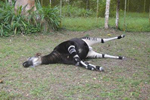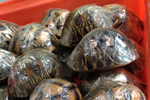Popularization of the world’s strangest coffee may be imperiling a a suite of small mammals in Indonesia, according to a new study in Small Carnivore Conservation. The coffee, known as kopi luwak (kopi for coffee and luwak for the civet), is made from whole coffee beans that have passed through the guts of the animal and out the other side. The coffee is apparently noted for its distinct taste, though some have argued it is little more than novelty.
“Originally, the dung-covered beans were collected in coffee plantations but more recently, as more people wanted to drink coffee made from beans that had passed through the intestines of this small carnivore, entrepreneurs have begun sticking civets in cages, feeding them coffee beans and recollecting them from the dung for wholesale,” the paper’s author, Chris Shepherd the deputy regional director with anti-wildlife crime NGO TRAFFIC, told mongabay.com. “Reportedly, as demand rose, other civet species were captured and added to these captive civet coffee makers.”
 Common palm civet. Photo courtesy of Chris Shepherd. |
Now, this burgeoning kopi luwak industry is creating “civet farms,” whereby civets are stolen from the wild and kept in cages to eat and expel coffee beans.
In 2010 and 2012, Shepherd visited several markets in Jakarta. He documented vendors selling 30 civets in three species: small Indian civet
(Viverricula indica), common palm civet (Paradoxurus hermaphroditus), and the small-toothed palm civet (Arctogalidia trivirgata). While none of these species are currently considered threatened yet by the IUCN Red List, Shepherd says the trade, which is completely unregulated, is likely hurting populations.
“While no research on populations are being carried out to measure the impact of this trade, it is sure to have a detrimental impact,” he says, “some species of civets are already threatened by habitat loss, hunting etc, and this is just one more pressure.”
The binturong (Arctictis binturong), a close relative of the civets which has also been used to make the coffee, is currently listed as Vulnerable.
In addition, the trade is seen by many as cruel and inhuman, with animals living out their lives in cramped cages and fed poorly. Shepherd writes that laws need to be updated in Indonesia to better-monitor and regulate the civet coffee trade. In addition, improved law enforcement is needed at these markets where many endangered species are sold illegally.
“To me, this is the most ridiculous threat to civets, or to any wildlife, I have seen yet,” says Shepherd, who has spent many years working to stop illegal wildlife trafficking. ” Do people drinking this coffee know what a civet is? Do they know that animals are being taken from the wild for their cup of coffee? And do they know that the beans ground to make their coffee have been eaten and crapped out by a smelly, furry little animal?”

Civet being sold in Jakarta market for the civet coffee trade. Photo by: Chris Shepherd.

Civet coffee for sale in Jakarta airport. Photo by: Chris Shepherd.
CITATION: Chris R. Shepherd. Observations
of small carnivores in Jakarta wildlife markets, Indonesia, with notes on trade in Javan Ferret Badger Melogale orientalis and on the increasing demand for Common Palm Civet Paradoxurus hermaphroditus for civet coffee production. Small Carnivore Conservation, Vol. 47: 38–41, December 2012.
Related articles
Double bad: Chinese vessel that collided with protected coral reef holding 22,000 pounds of pangolin meat
(04/15/2013) What do you do when you’re smuggling 22,000 pounds of an endangered species on your boat? Answer: crash into a protected coral reef in the Philippines. Last Monday a Chinese vessel slammed into a coral reef in the Tubbataha National Marine Park; on Saturday the Filipino coastguard discovered 400 boxes of pangolin meat while inspecting the ship. Pangolins, which are scaly insect-eating mammals, have been decimated by the illegal wildlife trade as their scales are prized in Chinese Traditional Medicine and their meat is considered a delicacy.
Market figures out that geckos don’t cure AIDS, but killing continues
(04/12/2013) Millions of tokay geckos continue to be traded for traditional medicine, despite waning belief that the colorful lizards are a cure for AIDS, reports a new study from TRAFFIC.
Infamous elephant poacher turns cannibal in the Congo

(04/03/2013) Early on a Sunday morning last summer, the villagers of Epulu awoke to the sounds of shots and screaming. In the eastern reaches of the Democratic Republic of the Congo, that can often mean another round of violence and ethnic murder is under way. In this case, however, something even more horrific was afoot.
Poachers enlisting impoverished wildlife rangers as accomplices in elephant, rhino killing
(04/01/2013) Corruption among wildlife rangers is becoming a serious impediment in the fight against poaching, fuelled by soaring levels of cash offered by criminal poacher syndicates, senior conservation chiefs have admitted. Rangers in countries as diverse as Tanzania and Cambodia are being bribed by increasingly organised poaching gangs keen to supply ivory, rhino horn and tiger parts to meet huge consumer demand in Asia.
A thousand soldiers sent after marauding elephant poachers [warning: graphic photos]

(03/26/2013) Eight Central African nations have announced they will send a thousand soldiers after poachers responsible for slaughtering 89 elephants, including over 30 pregnant mothers, in Chad earlier this month. The mobilization of soldiers and law enforcement officers could be a sign that Central African countries are beginning to take elephant poaching, which has decimated populations across Africa, more seriously.
Over ten percent of a species’ total population found in smuggler’s bag

(03/25/2013) On Friday, March 15th Thai authorities arrested a 38-year-old man attempting to collect a bag containing 54 ploughshare tortoises (Astrochelys yniphora) and 21 radiated tortoises (Astrochelys radiata) in Suvarnabhumi International Airport. Found only in Madagascar both species are listed as Critically Endangered and protected under the Convention on International Trade in Endangered Species (CITES), but have become lucrative targets for the black-market pet trade given their scarcity and beauty.
(03/19/2013) In what is being called the worst elephant massacre in Africa this year, poachers have recently killed as many as 89 elephants in Chad. Stephanie Vergniault, the Chairman of SOS Elephants in Chad, says the elephants were slaughtered in a two-day period late last week near Tikem, on the southwest border of Chad and Cameroon. At least 30 of the elephants were pregnant. Images from a television news report show what appear to be an elephant still connected to its umbilical cord on the ground. Separately, 12 calves were also slaughtered.
Elephant woes: conservationists mixed on elephant actions at CITES

(03/14/2013) Conservationists couldn’t agree if the glass was half-full or half-empty on action to protect elephants at the Convention on International Trade in Endangered Species (CITES) in Bangkok, Thailand. Elephants, especially in Africa, have faced a massive rise in poaching over the last decade with tens-of-thousands shot dead every year. Forests elephants in central Africa have been especially targeted: new research estimates that an astounding 60 percent of the world’s forest elephants have been slaughtered for their tusks in the last ten years alone. While conservationists had hopes that CITES would move aggressively against elephant poaching, the results were a decidedly mixed-bag.
Photographers threatening the already-abused slender loris
-Arun-Kanagavel.150.jpg)
(03/12/2013) Caught in a beam of torchlight, the eyes of the slender loris reflect back a striking glow. In an effort to better understand these shy, nocturnal primates, a team of researchers set out to the Western Ghats of India. The resulting paper: Moolah, Misfortune or Spinsterhood? The Plight of the Slender Loris (Loris lydekkerianus) in Southern India was published in the Journal of Threatened Taxa in January of 2013. Forest walks and interviews with the Kani people, who live in close proximity to the lorises, supported evidence of a surprising new threat to the lorises: photographers.